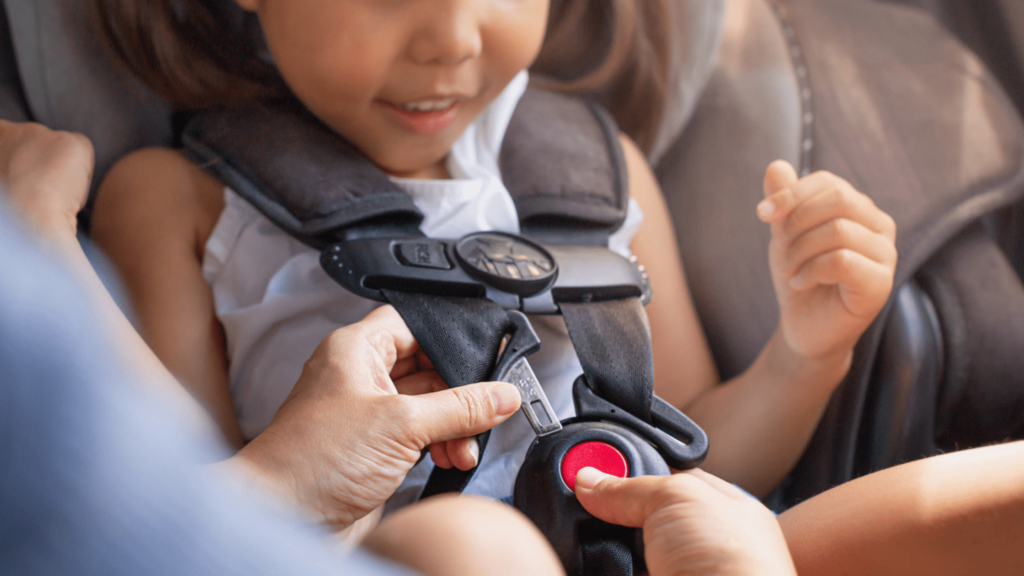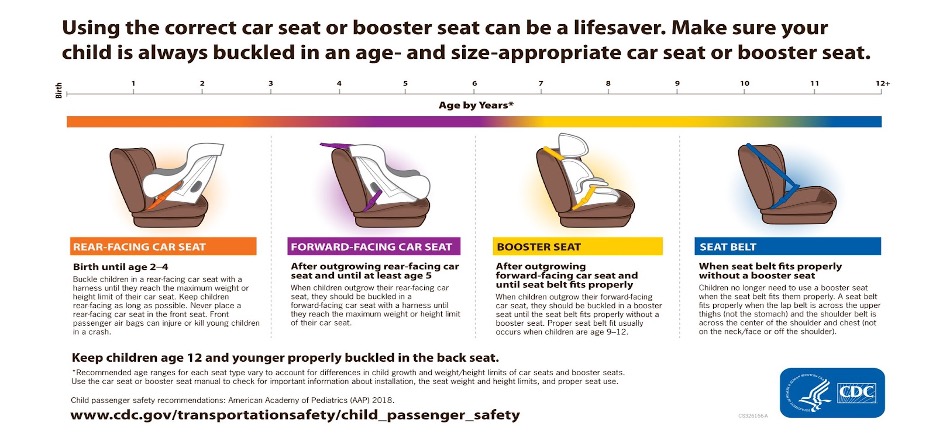- News
- National Child Passenger Safety Awareness Month: Protecting Michigan’s Most Vulnerable Passengers
National Child Passenger Safety Awareness Month: Protecting Michigan’s Most Vulnerable Passengers

As you probably know, September marks several special holidays and commemorative events. There’s Labor Day, of course, plus Rosh Hashanah and Yom Kippur… not to mention the autumnal equinox on September 23rd! But were you aware that the entire month of September is Child Passenger Safety Month? This observance aims to promote safe transportation practices and encourages proper child car seat use across the country. As such, we’re taking the opportunity to raise awareness of legal responsibilities concerning child car seats, answer frequently asked questions about car seats, and discuss best practices for helping prevent injuries to children while traveling Michigan’s roadways — not only this month, but all year long.
Why Are Car Seats Mandatory?
Parents and legal guardians know that Michigan has long required drivers to adhere to child safety car seat requirements enacted to protect kids on our state’s roadways. Simply put, legislators realized years ago that child car seats save the lives of countless children and keep many more from suffering serious injuries. The Centers for Disease Control, in fact, estimates that proper use of car seats reduces the risk of injuries to children by more than 70 percent compared to kids who are wearing only seat belts. And, of course, children who are completely unbuckled are far more likely to be injured or killed in a car accident. How vast is the problem, exactly? Nationwide, nearly 1,200 child passengers died in 2021, while over 160,000 were injured. Without car seat laws, which are now on the books in all 50 states, both of those numbers would have been much, much higher.
Where Should I Install My Child’s Car Seat?
Always place your child’s car seat in the back seat of your vehicle (unless there is no back seat). While there’s no strong data one way or the other, anecdotal evidence suggests that putting the car seat in the middle of the back, or even directly behind the driver, might be safer than placing it in the right side of the car. That could stem from the longstanding belief that the passenger side of a vehicle is generally less safe than the driver’s side. In fact, the front, passenger seating position has sometimes been called the “suicide seat” because it was believed that drivers were less likely to see, and thus less able to avoid, onrushing cars coming from the passenger side. So if at all possible, the best place to install a child car seat is definitely in the middle of the back seat according to the Mayo Clinic and other confirming sources… though we admit that placement could make reaching and buckling your child a bit less convenient.
Another reason to put kids in the rear seat versus the front comes from an NHTSA study cited by the National Institute of Health, which concluded that passenger airbags permit adults to occupy front seats more safely, which in turn allows parents to put kids in the safer back seat location without compromising the safety of front seat passengers. If you must have a child in the front seat – because all the back seats are occupied or you have a two-seat car – be sure to consider the American Academy of Pediatrics’ suggestion to deactivate your vehicle’s front passenger airbag. Michigan law also requires the front passenger airbag to be turned off if you must use a rear-facing child seat there (if, for instance, you own a two-seat vehicle, or all the rear seats are already occupied).
How Do I Properly Install a Child Car Seat?
Car seat manufacturers follow strict engineering and safety protocols when designing and testing their products. They know best how to install their car seats to ensure maximum safety, so carefully follow the directions that came with your child’s car seat. If you’ve received a second-hand car seat, it might have a label with installation instructions. If not, visit the manufacturer’s website to find the user manual for your specific car seat model. The National Highway Traffic Safety Administration also provides detailed instructions on choosing and installing car seats, along with an interactive car seat selection tool. They even provide a directory of locations where you can have your car seat inspected for safe and proper installation by trained technicians at no cost to you. Additionally, Michigan’s Office of Highway Safety Planning has published a guide showing how to avoid some common errors in car seat installation.
Another thing to know is that since 2002, most passenger vehicles in the United States have been manufactured with the “Lower Anchors and Tethers for Children” system (better known as the LATCH system). It includes metal anchors to which your car seat can be easily clipped. Check your car’s owner manual for details on placement of the anchors, which are usually near the bottom of the rear seat and are sometimes indicated by “buttons” on the seat cushion to help you locate them. While LATCH is convenient, experts generally suggest that once a child exceeds 45 pounds it’s preferable to secure child car seats using the vehicle’s regular seat belts. The NHTSA reports that the LATCH system is designed to accommodate a maximum weight capacity of 65 pounds, and some car seats can approach 20 pounds even when empty.
For more help on this topic, you can also seek out a Certified Child Passenger Safety Technician. There are nearly 500 of these folks scattered across Michigan, and you can use this interactive search tool to find someone near your location. Many of these techs work in local law enforcement or fire departments, so there’s very likely to be help close to home!
Which Direction Should My Child’s Car Seat Face?
The answer to that question depends upon your child’s age. An expert from the University of Michigan states that rear-facing car seats should be used as long as possible to help prevent infants’ and toddlers’ heads from being violently thrown forward in a head-on collision. Other experts recommend the continued use of rear-facing car seats for toddlers up to ages 2 or 3 years old. Once your child outgrows a rear-facing car seat, you can switch to a front-facing seat, which usually has a five-point harness that offers secure restraint at the shoulders, hips, and between the legs. Older children, from 4 years old up to age 8, can use either NHTSA-recommended car seats or booster seats.
How Long Should My Child Continue to Use a Car Seat?
In Michigan, kids up to age 4 are legally required to be restrained in car seats in the rear seat of your vehicle and, according to state law, children up to age 8 or less than 4 ft. 9 in. tall must still use child safety car seats or booster seats. In general, experts recommend that once children reach age 8 or are at least 4 ft. 9 in. tall, they begin to use your car’s regular seat belts. If that sounds extreme, consider that the United Kingdom mandates that children must remain in car seats until age 12 or they reach 135 cm (around 4 ft. 5 in. tall). Here in the United States, the Centers for Disease control have developed a timeline fact sheet outlining proper car seat styles to use based on your child’s age.

When Does My Child’s Car Seat “Expire?”
Like that mysterious package of yogurt lurking in the back of your refrigerator, you might imagine a car seat can last forever. But both do have expiration dates. In fact, car seats are usually stamped with their dates of manufacture, and some also indicate when they should stop being used. Why? It’s a matter of technology continually improving, and plastics continually degrading. A Washington Post article discusses this in some detail, noting that the wide range of temperatures and other conditions a car seat experiences in your vehicle can ultimately result in its failure. And, of course, engineers and crash test experts are continually working to make car seats safer and more effective. (Not to mention including convenient additions like cupholders!) In general, regardless of the product’s apparent condition, experts recommend that car seats should be replaced and recycled when they are more than six years old. To help minimize waste, Target has offered a car seat trade-in program for several years, and its website says the company will conduct this event again in September 2024.
What Should I Do About My Child’s Puffy Coat in Frigid Michigan Winters?
In three simple words: Take. It. Off. At least that’s what the American Academy of Pediatrics recommends. Because, as this terrifying crash test video shows, a bulky winter coat can cause your child to be thrown headfirst from the car seat in the event of a collision. The coat can prevent car seat straps from remaining snug and in place around your child’s shoulders. Of course, winter coat removal presents other nagging issues … such as cold, complaining kids. However, Consumer Reports magazine offers a creative solution: Have your children put on their coats backwards over their arms once they are safely strapped in their car seats. For smaller kids, have a blanket handy, and tuck them into their car seats with the blanket over the straps. It’ll be comfy, cozy and a bit fun, at least until the novelty wears off or next April arrives (whichever comes first).
What Happens if I’m Pulled Over and My Child Isn’t in a Child Restraint?
To paraphrase the iconic sheriff in a classic Dodge Challenger TV commercial, you could find yourself in a “heap of trouble.” Michigan law stipulates that fines assessed for not having children in car seats begin at $65 per incident, and you should also know that autoinsurance.org reports your car insurance rates can be affected if you’re cited for such safety offenses. But why would you want to take chances with your kids’ safety anyway? Car seats are not all that expensive… and low-income Michigan families are eligible for free car seats through a helpful Michigan State Police program.
Finally, Keep Your Kids Safer by Staying Safe Yourself
We hope knowing all this will convince you to keep your kids safely in their car seats wherever you’re on the road. And please allow us to take a moment to urge you to buckle up for your own safety too. We probably don’t need to remind you, but driving without a seatbelt fastened is also illegal in Michigan. So, remember to set a good example for your kids and click it (or ticket!), because your seat belt can save your life if you ever have the misfortune to become involved in a crash. Of course, if that unfortunate circumstance ever does happen to you, we also have another piece of advice: contact us here or dial 855-MIKE-WINS (855-645-3946) right away. We’re always ready to help accident victims get the compensation they need so they can recover from their injuries and resume their lives as quickly as possible. In the meantime, buckle up and drive safely!

Content checked by Mike Morse, personal injury attorney with Mike Morse Injury Law Firm. Mike Morse is the founder of Mike Morse Law Firm, the largest personal injury law firm in Michigan. Since being founded in 1995, Mike Morse Law Firm has grown to over 200 employees, served 40,000 clients, and collected more than $1.5 billion for victims of auto, truck and motorcycle accidents. The main office is in Southfield, MI but you can also find us in Detroit, Sterling Heights and many other locations.








